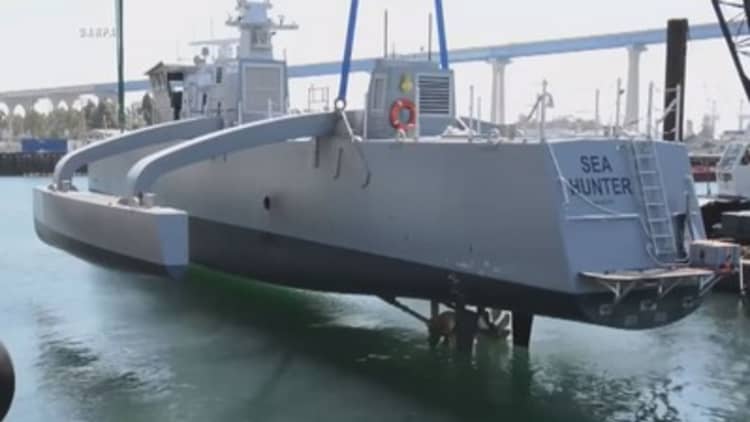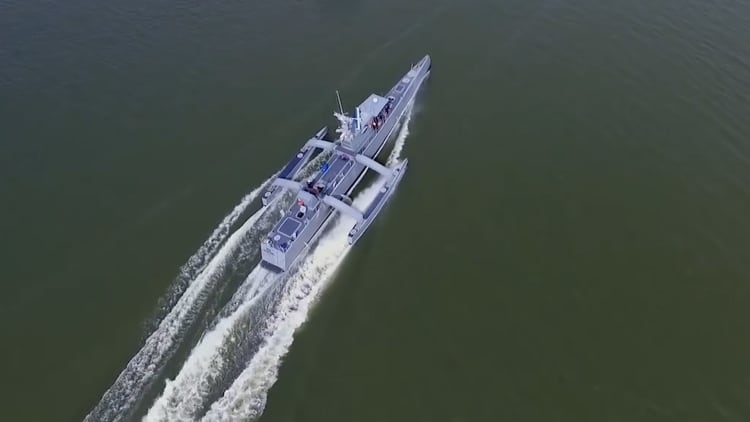
The first warship to traverse open waters without a single crew member recently joined the U.S. Navy's fleet after eight years of development and testing.
And now nearly every element of the vehicle, known as the Sea Hunter, has become classified.
"About all I can tell you is that it has transitioned from [the Defense Advanced Research Projects Agency] to the Navy, and that's a success in the world of science and technology," said Rear Adm. Nevin Carr. "And that's a good thing, because that means that there's a there there."
Carr talked to CNBC about the vessel's status shift during the Sea-Air-Space conference, the largest maritime expo in the United States. He is uniquely familiar with Sea Hunter since he oversaw its testing as chief of the Office of Naval Research and its current development as Leidos vice president and Navy strategic account executive.
Leidos is the sole defense contractor helping to engineer the vessel.
The product of 'mad science'
The concept for the unmanned vessel was born in 2010 out of the Pentagon's so-called mad science wing, the Defense Advanced Research Projects Agency, or DARPA.
The Pentagon's request from DARPA was colossal: Develop a drone warship capable of hunting submarines, detecting torpedoes and avoiding objects at sea while traveling at a top speed of 27 knots, or 31 mph.
Six years later, the crewless, 140-ton, 132-foot-long robotic ship, was christened as Sea Hunter on the Willamette River in Portland, Oregon.
"The project is classic DARPA, not only game-changing but paradigm-bending," Paul Scharre writes in "Army of None: Autonomous Weapons and the Future of War."
"Sleek and angular, it looks like something time-warped in from the future," adds Scharre, a former U.S. Army Ranger and senior fellow at the Center for a New American Security. "With a long narrow hull and two outriggers, the Sea Hunter carves the oceans like a three-pointed dagger, tracking enemy submarines."
On hand for the ship's 2016 christening was then-Deputy Secretary of Defense Robert Work, who referred to the vessel's narrow bow as a "Klingon Bird of Prey" from the "Star Trek" series.
"This will operate wherever the United States Navy operates," Work told reporters after the ceremony. "It can operate in the South China Sea. It can operate in the Baltic Sea. It can operate in the Persian Gulf. And it can operate in the middle of the Atlantic or the middle of the Pacific."
"These will be everywhere," he added.
After its unveiling in 2016, Sea Hunter was transferred to the Navy for nearly two years of testing off the coast of California. Since the drone ships' inception, the Navy and Leidos have been hesitant to provide updates on its future role.
A fraction of the cost of a destroyer

Secretary Work also noted the financial value of adding Sea Hunter to the Navy's fleet.
Sea Hunter's $20 million price tag is a fraction of the cost compared with a new Arleigh Burke-class destroyer, which would require approximately $1.6 billion in defense funds.
The drone ship also has an estimated operating cost ranging from $15,000 to $20,000 a day whereas a destroyer costs $700,000 a day to operate.
Carr notes, however, that Sea Hunter was not designed to replace naval vessels but collaborate with them.
"People see something like Sea Hunter and they think you want to replace my ship, and it's not that at all," Carr said. "An autonomous thing does not replace a manned thing it augments. It's not a one for one replacement."
Last year, Leidos, was awarded a $35.5 million Navy contract to build the second unmanned vessel dubbed Sea Hunter II.
And while another drone ship is on the way, it remains to be seen what missions the Navy has envisioned for Sea Hunter and its sister.
"The original model was that this would be an automatic submarine hunter," Carr said. "What we learned along the way is that the real power wasn't in any particular mission, it was having an autonomous pickup truck that could go away for long periods of time and have a persistent capability for whatever mission the Navy wants to do."
Sea Hunter is currently not equipped with weapons, but Work, the former deputy Defense secretary, described a scenario in which one day it could be armed.
"We might be able to put a six pack or a four pack of missiles on them. Now imagine 50 of these distributed and operating together under the hands of a flotilla commander," Work said. "This is going to be a Navy unlike any navy in history, a human-machine collaborative battle fleet that will confound our enemies."


